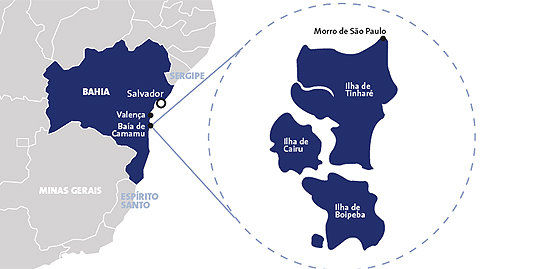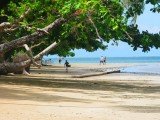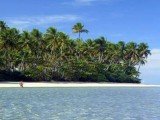Este post também está disponível em:
Português
English

Boipeba has more than 20 km of semi-deserted beaches, great for swimming.
No fancy restaurants, axé, lounge music, lights, shop windows or street vendors disturbing the calm by insistently offering their products.
Boipeba remains tranquil. It combines natural beauty with local originality. To complete the seasoning, it still preserves an air of alternative community.
The mouth of the Inferno River, which separates Boipeba from Tinharé Island, where Morro de São Paulo is located, seems to announce, in a stripped-down atmosphere, what lies ahead.
Upon disembarking at Boca da Barra, one realizes that those looking for peace and quiet will find it there.

Right in front of the boats is the entrance to Velha Boipeba, a 17th-century village where you can only walk and which, for the time being, has not become an open-air shopping mall, as happened with Praia do Forte, on the north coast of Bahia.
The climate by the sea is no different. There are about 20 km of semi-deserted beaches. Take as an example a walk from Tassimirim, with rock formations and natural pools at low tide, to Moreré.
On the way, a break to taste a lobster baked in the sea water itself at Guido’s tent, on Cueira beach, with practically no construction and coconut trees as far as the eye can see.
By the way, Cueira is one of the best places on the island for swimming. There are surfers, but the sea is not rough. Extensive shore, cliffs and rocks in the corners, with a long strip of sand shaded by coconut trees.

The villages of the Archipelago, such as Morro de São Paulo, Garapoá, Moreré, Velha Boipeba, Gamboa, …among others, are very popular with foreign tourists and, unfortunately, still little known by Brazilians.

Boipeba Island, which is located in the most privileged place of the Archipelago, is paradisiacal: sun all year round, virgin beaches, turquoise sea with crystal clear waters, vast biodiversity, total tranquility and a totally hospitable and receptive population!
Videos about Boipeba Island


Ilha de Boipeba - Reportagem

Ilha de Boipeba - Guia de Turismo

Ilha de Boipeba - Guia de Turismo Completo

Ilha de Boipeba - Guia de Viagem Completo09:50

Moreré - Guia Completo26:03
What to do in Boipeba Island
Among the tour options, diving and marine contemplation in the pools of Bainema cannot be missed.
In January, at the height of summer, they become more beautiful, blue and translucent when the tide is low. The tour is done by speedboat and a good tip is to take or rent diving masks and snorkel to see the diversity of fish and the colorful marine life.

The Praia de Castelhanos, one of the most beautiful in Boipeba, also needs to be on the itinerary. It is the perfect place for those who like empty beaches, without many tourists, even in summer. There, in addition to coconut trees, pools that form at low tide and a white sand, you can taste pastries and other typical snacks in the stalls.
Another enchanting walk is the walk to Moreré, which includes the passage through the beaches of Tassimirim and Cueira, crossing the river of Aritibe and the coconut grove of the “Italian’s farm” until reaching the beach. The route is one of the most beautiful in all of Bahia.
The Boca da Barra beach is also among the most incredible spots on Boipeba Island. It is there that the Pousada Mangabeiras is located, in a property surrounded by several species of local flora, such as dendezeiros, coconut trees, cajazeiras, araçás, cashew trees, bromeliads, biribas, ferns, orchids and mangabeiras.
The place is an oasis for those seeking tranquility and comfort. Its charming bungalows guarantee a privileged view of the sea, in addition to the integration with the green, since they are distributed along the paths and gardens that also house the pool, the deck and the corners reserved for relaxation and meditation.

Beaches of Boipeba
1. Boca da Barra
It is where most of the inns are located, very close to the village of Velha Boipeba. Depending on the tide the water is darker, due to the mangrove water brought by the Rio do Inferno, which flows into this place, right in front of the island of Tinharé.
2. Outeiro
It is the continuation of Boca da Barra, after the “curve” towards the open sea. The water is already a little clearer, but you can also notice the tide differences.
3. Das Pedras
It is a tiny little beach, next to the trail from Outeiro to Tassimirim, which, as expected, is full of stones.

4. Tassimirim
The beach is reached by a trail from Outeiro beach, about 20 minutes walk.
It is beautiful, protected by corals. But it is a beach much more to look at than to bathe, as there is coral everywhere. It is practically deserted.

5. Coeira
Separated from Tassimirim beach by a coral block, if no one tells you, you don’t even realize you’re on another beach. But there is one surefire clue: this beach has waves.
Sure, it’s no Hawaii, but there are days when people surf there. But usually it’s much more for swimming.
In the middle of the beach it’s better, because there’s no more coral, and of course, there’s no residents either.

6. Moreré
This one looks like what you’d expect from paradise!

The water is transparent, shallow, the sand white, framed by an immense coconut grove, and some restaurants in the best style of a vacation movie on a tropical island of the afternoon, with their thatched roofs, chairs and rough wooden tables.
The delicacies served there are only there: the shrimp moqueca with banana and the grilled fish are not to be missed.

7. Bainema
At the end of Moreré beach there is a beautiful trail that leads to another beach, of course, deserted.
On the way there are some cajá trees, and if you are lucky you will even find some of these fruits.
The sand on the way is dark, so hot: go with flip-flops! The beach is beautiful, and with a little luck, you can even see flocks of herons in the late afternoon.
8. Ponta dos Castelhanos
Accessible only by boat, and as expected, practically deserted.

It is not completely deserted because there is a fisherman living there, in a straw house, right at the beginning of the beach.
But if you walk to the first bend in the beach, no one will mind if you walk there naked, or stay stretched out in the sun for hours.

9. Cova da Onça
It is the last beach in the south of Boipeba. It has a village, also known as São Sebastião, where about 700 people live.
Tourism has not yet arrived there. The tranquility is total.
10. Pontal or Pratigi
It is on the island of Tinharé, north of the island of Boipeba, but it is easier to get there by Boipeba than by Morro de São Paulo.
Just cross the channel of Rio do Inferno, in front of Boca da Barra. There is only one house, owned by an Italian who comes there once a year.
11. Garapuá
It is also on the island of Tinharé, but a little further away. The best is to go there by boat and eat a lobster guelhada or octopus rice from Iracema’s stall.
Bahia.ws is the largest tourism and travel guide for Bahia and Salvador.
Tourism and Travel Guide to Boipeba Island in Bahia



















